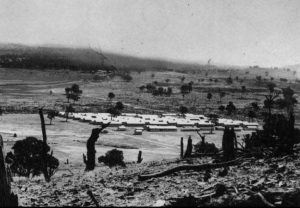
The Puckapunyal military training grounds during the Second World War. Large swathes of the Puckapunyal site were left barren and denuded as the result of military exercises. Source: Argus Newspaper Collection of Photographs, State Library of Victoria.
Military operations can have repercussions for environments and landscapes a long way from the battlefields. In the case of Australia most military action during the 20th century happened far from its shores, apart from the incidental bombing by the Japanese of Darwin and a few other northern coastal towns during World War II. It is therefore surprising that an Australian historian, Ben Wilkie, Honorary Research Fellow in Australian Studies at Deakin University, researches the environmental histories of military conflict. This edition of the podcast explores some of these histories of militarized landscapes in Australia, and the evolution of Australian Defence Force environmental policies in the twentieth century with Ben Wilkie.
Further reading and resources
Bombs & Biodiversity: A blog about the environmental legacies of war and conflict
Benjamin, Wilkie, ‘Bombs and Biodiversity: A Case Study of Military Environmentalism in Australia’, Environment & Society Portal, Arcadia Autumn 2016, no. 15. Rachel Carson Center for Environment and Society. doi.org/10.5282/rcc/7678
Benjamin Wilkie, ‘Defence white paper shows Australian forces must safeguard nature too’, The Conversation, 26 February, 2017.
Jock H. Pick, Australia’s dying heart: soil erosion in the inland (Melbourne: Melbourne University Press, 1942)
Peter Coates, Tim Cole, Marianna Dudley, and Chris Pearson. ‘Defending Nation, Defending Nature? Militarized Landscapes and Military Environmentalism in Britain, France, and the United States’, Environmental History 16, no. 3 (2011): 456–91.
Music Credits
“Battlefield Taikos” by rocavaco
“Too Small to Sweat” by Stefan Kartenberg
Tracks available from ccMixter


Recent Comments